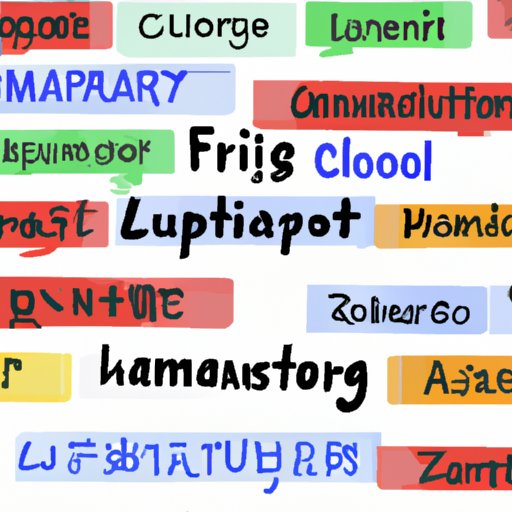Introduction
Language is an essential part of human life, enabling us to communicate with each other and express our thoughts, feelings, and ideas. On a global level, language is a crucial factor in international relations, facilitating communication and understanding between different cultures and countries. This article explores what language is the most spoken worldwide, examining various sources for reliable information and investigating the linguistic diversity of the globe.
Researching the Most Spoken Language in the World
The most accurate way to determine which language is the most spoken worldwide is to look at the number of native speakers. According to estimates from Ethnologue, a comprehensive language database, Mandarin Chinese is the most widely spoken language in the world, with over 1 billion native speakers. This is followed by Spanish, with around 460 million native speakers, and English, with around 360 million native speakers. Hindi and Arabic are also major languages, with around 260 and 250 million native speakers respectively.

Exploring the Various Languages Across Continents
When it comes to language use around the world, there is a great deal of regional variation. In Europe, the Romance languages (Spanish, French, Italian, and Portuguese) are the most commonly spoken, while German, Russian, and Turkish are also widely used. In Asia, Mandarin Chinese is the dominant language, followed by Hindi and Urdu in India, Korean in Korea, Japanese in Japan, and Thai in Thailand. In Africa, Arabic is the most widely spoken language, followed by Swahili, French, and Hausa. In the Americas, Spanish is the primary language, followed by Portuguese in Brazil and English in the United States.
Examining the Linguistic Diversity of the Globe
The world is home to thousands of languages, representing a diverse range of cultures, histories, and geographies. While some of these languages are closely related, others have little in common. Language plays an important role in defining culture and identity, and it can be a powerful tool for preserving cultural heritage. It can also be a source of conflict, as different languages can be seen as a barrier to communication and understanding.

Investigating the Global Language Landscape
It is estimated that there are around 7,000 languages spoken around the world today. However, only a few of these languages are widely used. According to estimates, 95% of the world’s population speaks one of the 23 most widely used languages. These include Mandarin Chinese, Spanish, English, Hindi, Arabic, French, Russian, German, Japanese, Korean, Portuguese, Italian, and Swahili. While these languages are the most widely used, there are many other languages spoken around the world, including indigenous languages, minority languages, and regional dialects.

Comparing Languages Used Around the World
When comparing languages, there are several factors to consider. The first is the number of native speakers – this can give an indication of the size and reach of a language. Other factors include the geographical spread of a language, the amount of literature written in the language, and the degree of mutual intelligibility between languages. For example, languages like Spanish and Portuguese are mutually intelligible, making them easier to learn than languages that are not related.

Ranking the Most Widely Spoken Languages
When ranking languages according to their usage, it is important to take into account the number of native speakers, the geographical spread of a language, and the amount of literature written in the language. Based on this criteria, the top five most widely spoken languages in the world are Mandarin Chinese, Spanish, English, Hindi, and Arabic. These five languages account for almost half of the world’s population.
The Impact of Language on International Interactions
Language has a significant impact on international relations, both positively and negatively. On the one hand, language can facilitate communication and understanding between nations, allowing for smoother diplomatic relations and greater trade opportunities. On the other hand, language barriers can create misunderstandings and lead to conflicts. It is therefore important for governments and businesses to make sure they understand the language and culture of the countries they are dealing with.
Conclusion
In conclusion, the research conducted in this article suggests that Mandarin Chinese is the most spoken language in the world, with over 1 billion native speakers. Spanish, English, Hindi, and Arabic are also major languages, with large numbers of native speakers. Language has a significant impact on international interactions, and it is important for governments and businesses to understand the language and culture of the countries they are dealing with. Overall, language is a key factor in international communication and understanding, and will remain so in the future.


